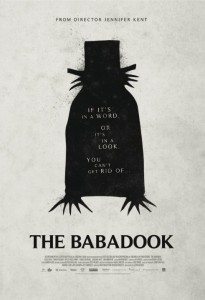 Horror hasn’t thrilled me of late. Found footage is tiresome and people hacking themselves to pieces doesn’t seem quite so interesting as it did in the early ‘80s. When I was 12. It all feels adamantly grim and meaningless, its purpose nothing more than to shock, startle, and disgust. Makes a guy want to saw his own head off.
Horror hasn’t thrilled me of late. Found footage is tiresome and people hacking themselves to pieces doesn’t seem quite so interesting as it did in the early ‘80s. When I was 12. It all feels adamantly grim and meaningless, its purpose nothing more than to shock, startle, and disgust. Makes a guy want to saw his own head off.
Then I saw The Babadook. And my faith in being honestly scared was restored.
The Babadook is exactly what I want horror to be. It sheds light on the darkest corners of what it is to be human by stepping outside of the real and into the horrific. It’s the story of a character in a pop-up book driving a single mother insane, to the point where she wants to kill her own child. Dark, indeed.
I can imagine viewers asking what they always ask of movies like this (The Shining comes immediately to mind): does the monster in the book actually exist? Or is it only the visual manifestation of the mother’s insanity? Well. In the world of the movie, a monster takes over a mother’s brain and drives her to commit evil acts. So yes. It happens. But what the movie is exploring is the taboo subject of the pain of motherhood. The movie is metaphor.
I mean not that every mother is thinking she’d like to kill her kids. And yet, sometimes? Once? Fleetingly? A momentary fantasy? Not what anyone likes to admit. But nobody said parenting was all puppies and rainbows. Did they? If so, they’re lying.
Amelia (the marvelous, fully committed Essie Davis) has been a single parent since her boy, Samuel (Noah Wiseman, quite the actor for a six-year-old), was born. Driving her to the hospital to give birth, her husband crashed the car and died. Happy birthday, son!
We meet Amelia and Samuel two weeks before his seventh birthday. He’s never celebrated his birthday on the actual day of his birth. Seems not to be Amelia’s best day. In fact, no days are Amelia’s best day. Samuel is a strange, hyperactive, possibly violent kid, and all he talks about, every day, to her, to kids at school, to teachers, strangers, everyone, is the Babadook.
The Babadook is a monster. It’s coming to get him and his mother. But he’s going to protect her.
One night he asks Amelia to read him the Babadook book, a large, red pop-up storybook, conceived of by the film’s writer/director Jennifer Kent and illustrator Alex Juhasz. Truly, it is the scariest pop-up book imaginable, consisting only of simple black and white drawings, and a very ominous story. I’m scared just thinking about it. It’s so good the filmmakers are now making reproductions, and I just ordered one (you can too, here).
The Babadook book is so demented that Amelia tears its pages to shreds and dumps it outside in a bin.
It shows up on her doorstep some days later, repaired, with a story somewhat different than before. This one’s about her. It shows her doing some very unpleasant things.
The movie tracks Amelia’s disintegration. At the outset she’s sleep deprived, stressed out, and depressed. She only gets worse. Samuel’s school isn’t happy about the Babadook-defeating weaponry he’s been bringing to class. He frightens the other children. No one wants to play with him.
Slowly but surely the action of the movie devolves to their house, and what might be living within it.
It’s a slow build of a movie, but every second of it is filled with tension. Most of which results not from the as yet unseen monster waiting in the wings, but from the relationship between Amelia and Samuel. He’s not a mean kid. He’s not evil. He’s just six. And he’s driving Amelia insane. The tension comes from the knowledge that someone’s going to do something horrible. Who’s it going to be? And what are they going to do?
There are no cats jumping out of cupboards in The Babadook, no grisly horror scenes. To me, the only moments that rang false were when too-snappy editing effects were used to make the appearance of Mr. Babadook scarier. Because those tricks don’t make him scarier. He’s scary enough as he is. He appears not through fancy bland CGI but in hand-made, simple form, through stop-motion aided by computers, inspired by the work of cinema pioneer Georges Méliès (some of whose work appears briefly glimpsed as Amelia, sleepless, flips through TV stations in the middle of the night). The design is lovely. And fucking terrifying.
Later in the movie, he approaches his victims from the darkness in a long, slow shot. Now that’s scary. He’s coming. So slowly. And there’s no escaping him. Like the book says, “You can’t get rid of the Babadook.”
The movie was made in Australia, but Kent wanted to give the neighborhood an “anytown” feel. Mr. Babadook could come to your town, too! Her inspirations appear to be horror movies from an earlier era, claustrophobic ones like The Shining and Repulsion. The cinematograpy by Radek Ladczuk tends toward the grey and colorless, creating a feeling of oppression (it suffers only in the way all digitally shot movies do these days–low-light scenes appear vague; nothing pops; oh, film, how I miss you!).
The Babadook is dark and tense and scary and disturbing. And in many very uncomfortable ways, real. If you’re a new parent, it might be one to skip. For everyone else, it’s not to be missed.


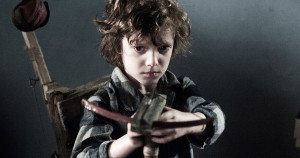
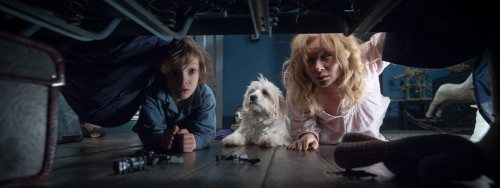
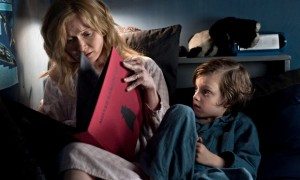
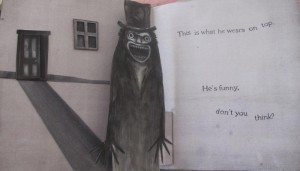
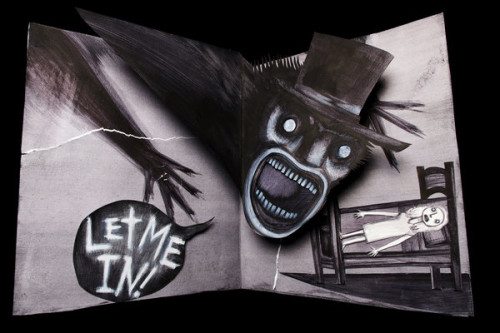
Hooray! I will skip this for, oh, 10 years or so. But maybe I will read your Babadook-book-book when it comes.
Man, I’m pissed I missed this in theaters. So much scarier in the dark.